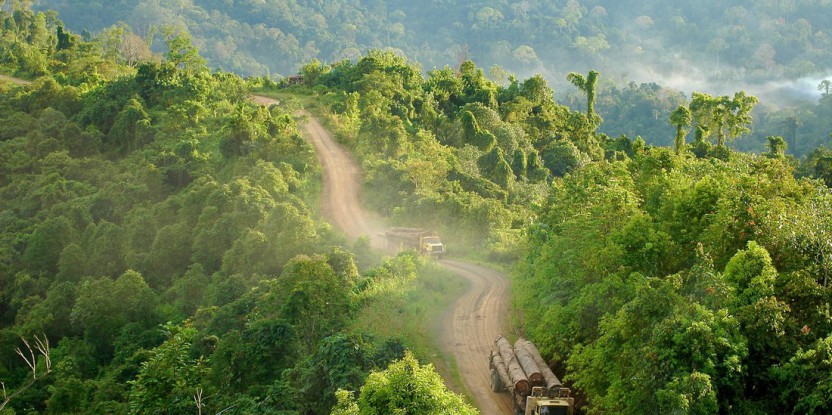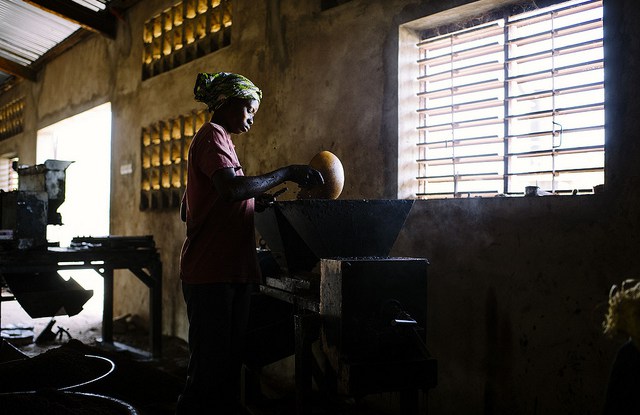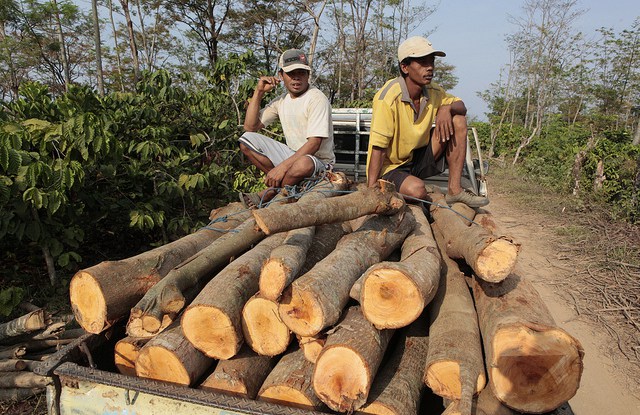BOGOR, Indonesia—With climate changing and populations growing, the demand for forest-based commodities has never been greater.
Ensuring the sustainability of products from palm oil to timber and everything in between looms as one of humanity’s biggest challenges.
All policy makers need to do is navigate global markets and a constellation of policy instruments while curbing deforestation and protecting the rights and livelihoods of small-scale producers—all in the face of climate change.
Piece of cake.
New research from the Center for International Forestry Research (CIFOR) is helping to show the path to solutions for sustainable sourcing of commodities from tropical forest landscapes. CIFOR’s Forests News recently asked three experts for their thoughts on the present, and future, of three tropical forest-based commodities: palm oil, shea nut oil and timber. An edited transcript of those interviews follows.
Patrice Levang, Scientist, CIFOR and CIRAD
On the relationship between palm oil and deforestation
The trouble is not the crop, or the sustainability of the crop. The problem is more that in order to grow palm oil, large international companies prefer to open large tracts of land. To find these the best possibility, from their perspective, is to clear large areas of tropical forest.
Once they have cleared it the crop itself is rather sustainable. If you clear the forest and you plant oil palm, the land is without cover for just a few weeks or months. Very quickly oil palm takes over and in three years the ‘canopy’ closes. You don’t need huge amounts of fertilizer. You don’t use too much pesticide. Soil also remains protected.
But when you convert forest you destroy huge biodiversity of the forest. You have hundreds if not thousands of species that disappear.
On addressing sustainability concerns on palm oil
One idea is to increase the yields in areas where you already have oil palm plantations, with the oil palm on lands that have been cleared in the past—degraded land. The problem with this is that already-cleared areas are already appropriated by smallholders, and so you have to negotiate with smallholders to help them to develop oil palm.
This brings us to preparing smallholder oil palm development, which would divert them from the primary forest and would at the same time help lift smallholders out of poverty. This would be a win-win situation. This has a slight cost for the company, however. Rather than bringing a nice check to the minister of forestry you have to engage with a lot of smallholders.
On the effects of climate change
So far we don’t really have any idea about the likely impact of climate change on oil palm in humid tropical areas. There is little chance that these areas will become more humid. It is in the marginal areas that the climate is more likely to impact the crops. In Africa this could prevent the expansion of oil palm to the northern parts. But research is looking for varieties that are better adapted to drier climates.
If we cannot plant oil palm in these relatively marginal areas it will mean that you impact more the humid parts and the primary forest areas. It would be good to be able to expand oil palm in savannah areas. You will lift people out of poverty.
On further research needed for sustainable palm oil
They are looking at genetic improvements to increase the potential yield of the crops. There are some trials. You could potentially grow up to 12 tons per hectare, three times more than the best average now, but you have to use very large amounts of fertilizers.
We have to convince countries like India and China to go for certified commodities
We also need to find ways to make oil palm a ‘smallholder friendly’ crop. This will need some proper liaison between the large companies and smallholders in the framework of outgrower schemes, or contractor farming between companies and smallholders. The companies make more profit on the conversion of the fruit to palm oil than they can make just from the plantation.
All the production can in theory be given to smallholders and the conversion of fruit to oil can be left to the companies. It was practiced in the past, but was more or less abandoned over time.
On palm oil’s ‘image’
The crop itself is not responsible for man’s wrongdoings. The crop is one of the most interesting crops man has developed so far. It produces eight times more oil than the second largest yielder of vegetable oil produces. You can use it as food. You can use it for biofuel and cosmetics. So you have different outlets.
Oil palm is a very good crop. But the conversion of huge tracts of primary forest has pushed many conservation NGOs to fight against palm oil. Rapeseed producers, soybean producers, also go out and distribute false information against it. This is precisely because palm oil is a dangerous competitor for them. Yields are much higher than what they produce and it is at a much lower cost.
It is also very practical for industry to use. So over the last 20 years palm oil has taken over a large part of the market. That is one of the major reasons why you see all these campaigns. You can find rapeseed producers and other producers of rival oils funding very aggressive conservation NGOs.
To make the name of the industry better I have developed a round table for sustainable palm oil. It provides certification for sustainable palm oil. Now certified palm oil means the company no longer cuts primary forests, no longer exploits their workers unduly and no longer endangers the livelihoods of indigenous people.
The very big companies have signed up, especially the ones listed on the stock exchange. But presently there is more certified oil on the market than people willing to buy it, because the main people buying it want cheap oil. They don’t want clean oil. The main buyers now are India, Pakistan, China. They go for cheap oil. If the major buyers are not willing to buy certified oil this situation might not change. But it was the same with certified timber. We have to keep on fighting and things are getting better. We have to convince countries like India and China to go for certified commodities. However, there is still a long way to go.
Andrew Wardell, Senior Manager, Research Capacity & Partnership Development, CIFOR
On changes in the industry for shea nut oil (main ingredient in shea butter)
For the past 200 years, shea nut oil has been a commodity that has been traded locally or regionally in Africa but not on a global scale. The manufacturers of chocolate can now substitute a small proportion of their cocoa butter with cocoa butter substitutes. Shea nut butter is the closest thing to cocoa butter.
Up to 5 percent of the total ingredients can be cocoa butter substitutes, but that 5 percent still represents a multimillion-dollar industry globally. The temperature at which the chocolate melts in your hands is higher with shea butter. It permits the buyer to hold it longer if you coat it with shea butter.
This now represents 90 percent of the world trade in shea nuts. The other 10 percent goes into the cosmetics industry. However, there is still a very important local and regional trade both as a cooking oil and also as a cosmetic product for dry skin.
On making shea nut oil sustainable
It has been a sustainable commodity for at least 700 years based on local trade. What has changed in the last 10 years is the emergence of this new global market for the global chocolate industry. It is restructuring. It is simply a question of responding to this demand.
What is not clear is whether this new demand will be met by natural regeneration. It is a tree that is very difficult to grow. It has recalcitrant seed. There have been attempts to develop this as a plantation crop for 80 years with no success so far.
On the effects of climate change
I think the scientific evidence suggests that the West African region, where this commodity mainly grows, may be at risk of further variations in climate.
We need to know more about what impacts globalized trade in the regional agroforestry lands in West Africa where most of the shea nut crop grows
This is a region that has had already for centuries regional variations in rainfall. There is evidence that suggests in fact the Sahel is greening, not browning. The only trend that can account for that is increased rainfall patterns, and we need to find out how that would affect this commodity.
On areas for further research
I think there is still a lot of information we don’t have. We need to know more about what impacts globalized trade in the regional agroforestry lands in West Africa where most of the shea nut crop grows.
Another unanswered question is what impact will the emergence of other cheaper oils such as palm oil have on local demand within Africa. Another is how to develop technology to improve regeneration of the plant.
On women’s roles in the shea nut oil industry
This crop has been almost exclusively controlled by women. They have historically controlled the harvesting, the processing and the marketing. That is what has started to change. You have a number of middlemen who are bulking up to provide a global supply chain. This is something that we need more research on.
One important future trend may be the emergence of something called the Global Shea Alliance, which is increasingly trying to provide alternative marketing routes to the three global companies that control the shea nut value chain. This is a new alliance that is trying to get on its feet.
Krystof Obidzinski, Senior Scientist, CIFOR
On the state of the tropical timber industry
Up until a couple of years ago we still had this very strong tendency to rely on market-based mechanisms to support legal and hopefully sustainable timber trade. Over the last five years what we see is a slow departure from that trend and we see governments stepping in and taking control more. These market-based mechanisms have not really achieved what they set out to. There is some progress, but in the overall scheme of things, progress has not been as fast as expected.
For example, Indonesia has signed a partnership agreement with the European Union on a scheme called SVLK—a Timber Legality Certification System. This is a government-based certification scheme that is mandatory for all timber enterprises in Indonesia, in theory. Indonesia has committed to this and said all timber that is traded from this country will have to be compliant with this SVLK standard.
In many ways, this kind of process is a step forward, but it also is still far from resolving all the issues that are supposed to be resolved. It helps in certain areas of forestry but it doesn’t really do much in others.
On making the timber industry more sustainable
I still think things like Indonesia’s SVLK system are useful, but they will require more work: They need further support and also simplification. We need to support enterprises with funding to offset the cost. This certification is expensive for smallholders. We need to ease the cost but also simplify procedures. It has to be easy. Otherwise it is never going to happen.
In terms of large-scale enterprises there is a lot of progress with verification. But the biggest problem is small and medium enterprises. They are going to lag behind for years. I don’t believe they can ever be truly compliant.
And the small and medium enterprise sector in Indonesia is so vast that even with strong support from the government it will take years and years to verify them. And even then you would never be certain that you have covered them all, because there is such turnover in this sector. Companies operate today. These close. New ones open up. Keeping up with this process is an almost insurmountable challenge.
Nobody really even knows how big this sector is. The government doesn’t really keep regular statistics on enterprises with capacity less than 6,000 cubic meters per year. There is no regularly updated record of them. Some estimates suggest in fact up to 10 million cubic meters of wood are consumed by these enterprises every year. It is significant. It involves hundreds of thousands of people, poor people—lots and lots of families in rural Indonesia.
On the effects of climate change
One thing people are realizing in Java, for example, is that these places have been denuded and there are water issues as a result. In many cases people have begun to realize that planting trees is part of the solution. If you look at timber production in Java most of the timber in Java now comes from smallholder tree growers. These planted smallholder forests are addressing some of these climate change problems.
Most of these smallholders basically are growing timber. They are not sourcing their timber from natural forests. Communal forests are supplying it.
On unanswered questions for the tropical timber industry
I think one of the bigger issues is bioenergy and biofuels. There is this growing interest in fiber-based energy. Now there is interest in fiber-based biofuels that come from timber. Japan and South Korea are increasingly switching to fiber-based fuels. That means they will be sourcing from countries like Indonesia. But is it going to be a conservation model where we actually have some kind of carbon sequestration going on?
There are also many issues surrounding whether small-scale forestry is going to become the main source for timber in Indonesia. In the future it is all about small-scale forestry, community forests.
We want you to share Forests News content, which is licensed under Creative Commons Attribution-NonCommercial-ShareAlike 4.0 International (CC BY-NC-SA 4.0). This means you are free to redistribute our material for non-commercial purposes. All we ask is that you give Forests News appropriate credit and link to the original Forests News content, indicate if changes were made, and distribute your contributions under the same Creative Commons license. You must notify Forests News if you repost, reprint or reuse our materials by contacting forestsnews@cifor-icraf.org.



